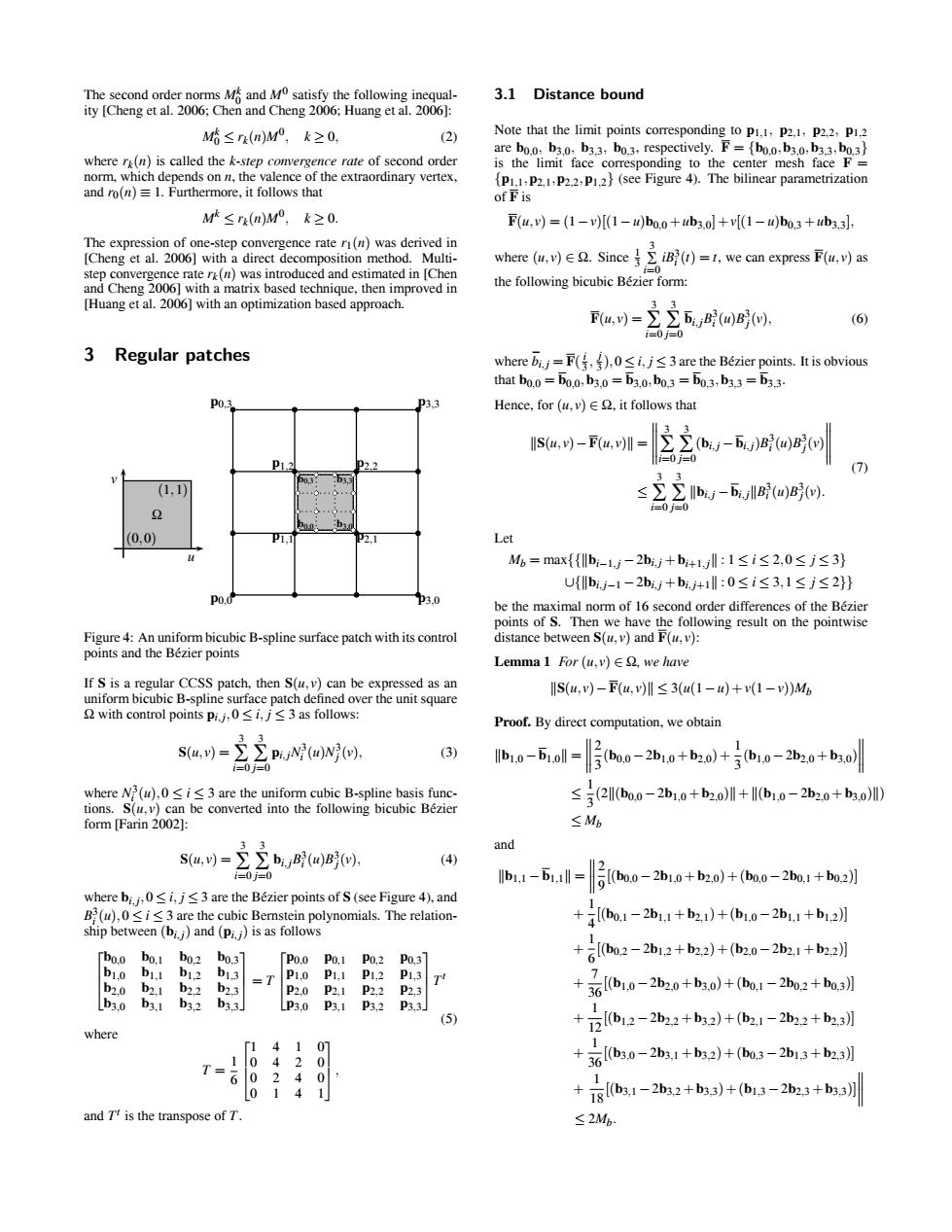正在加载图片...

Chm e Ch am Chn 3.1 Distance bound ,y-0-1-ha+h+(1-hs+ab u,-立5,m. 3 Regular patches 应产53e 风e-u-22y s立立y-,oj ne -- Ibia-5iall(bue-2hin+haa)+(+) 安-- sc.-). )+(bau-2ba+b +1-h11+21}+1.0-2b1,1+b12 +001-2h11+hmz}+bn0-2b1+b3j川 厨剑 +[b1D-2h2a+ba+b1-2h2+h) +(b:3-2b:3+bx3)+(bz.:+hz.) -用 0-+b]+-2h3+hThe second order norms Mk 0 and M0 satisfy the following inequality [Cheng et al. 2006; Chen and Cheng 2006; Huang et al. 2006]: Mk 0 ≤ rk(n)M0, k ≥ 0, (2) where rk(n) is called the k-step convergence rate of second order norm, which depends on n, the valence of the extraordinary vertex, and r0(n) ≡ 1. Furthermore, it follows that Mk ≤ rk(n)M0, k ≥ 0. The expression of one-step convergence rate r1(n) was derived in [Cheng et al. 2006] with a direct decomposition method. Multistep convergence rate rk(n) was introduced and estimated in [Chen and Cheng 2006] with a matrix based technique, then improved in [Huang et al. 2006] with an optimization based approach. 3 Regular patches u v (0,0) (1,1) Ω p0,0 p0,3 p3,0 p3,3 p1,1 p1,2 p2,1 p2,2 b0,0 b3,0 b0,3 b3,3 Figure 4: An uniform bicubic B-spline surface patch with its control points and the Bezier points ´ If S is a regular CCSS patch, then S(u, v) can be expressed as an uniform bicubic B-spline surface patch defined over the unit square Ω with control points pi, j,0 ≤ i, j ≤ 3 as follows: S(u, v) = 3 ∑ i=0 3 ∑ j=0 pi, jN3 i (u)N3 j (v), (3) where N3 i (u),0 ≤ i ≤ 3 are the uniform cubic B-spline basis functions. S(u, v) can be converted into the following bicubic Bezier ´ form [Farin 2002]: S(u, v) = 3 ∑ i=0 3 ∑ j=0 bi, jB3 i (u)B3 j(v), (4) where bi, j,0 ≤ i, j ≤ 3 are the Bezier points of ´ S (see Figure 4), and B3 i (u),0 ≤ i ≤ 3 are the cubic Bernstein polynomials. The relationship between (bi, j) and (pi, j) is as follows ⎡ ⎢ ⎣ b0,0 b0,1 b0,2 b0,3 b1,0 b1,1 b1,2 b1,3 b2,0 b2,1 b2,2 b2,3 b3,0 b3,1 b3,2 b3,3 ⎤ ⎥ ⎦ = T ⎡ ⎢ ⎣ p0,0 p0,1 p0,2 p0,3 p1,0 p1,1 p1,2 p1,3 p2,0 p2,1 p2,2 p2,3 p3,0 p3,1 p3,2 p3,3 ⎤ ⎥ ⎦ Tt (5) where T = 1 6 ⎡ ⎢ ⎣ 1410 0420 0240 0141 ⎤ ⎥ ⎦, and Tt is the transpose of T. 3.1 Distance bound Note that the limit points corresponding to p1,1, p2,1, p2,2, p1,2 are b0,0, b3,0, b3,3, b0,3, respectively. F = {b0,0,b3,0,b3,3,b0,3} is the limit face corresponding to the center mesh face F = {p1,1,p2,1,p2,2,p1,2} (see Figure 4). The bilinear parametrization of F is F(u, v)=(1−v)[(1−u)b0,0 +ub3,0] +v[(1−u)b0,3 +ub3,3], where (u, v) ∈ Ω. Since 1 3 3 ∑ i=0 iB3 i (t) = t, we can express F(u, v) as the following bicubic Bezier form: ´ F(u, v) = 3 ∑ i=0 3 ∑ j=0 bi, jB3 i (u)B3 j(v), (6) where b¯i, j = F( i 3 , j 3 ),0 ≤ i, j ≤ 3 are the Bezier points. It is obvious ´ that b0,0 = b0,0,b3,0 = b3,0,b0,3 = b0,3,b3,3 = b3,3. Hence, for (u, v) ∈ Ω, it follows that S(u, v)−F(u, v) = 3 ∑ i=0 3 ∑ j=0 (bi, j −bi, j)B3 i (u)B3 j(v) ≤ 3 ∑ i=0 3 ∑ j=0 bi, j −bi, jB3 i (u)B3 j(v). (7) Let Mb = max{{bi−1, j −2bi, j +bi+1, j : 1 ≤ i ≤ 2,0 ≤ j ≤ 3} ∪{bi, j−1 −2bi, j +bi, j+1 : 0 ≤ i ≤ 3,1 ≤ j ≤ 2}} be the maximal norm of 16 second order differences of the Bezier ´ points of S. Then we have the following result on the pointwise distance between S(u, v) and F(u, v): Lemma 1 For (u, v) ∈ Ω, we have S(u, v)−F(u, v) ≤ 3(u(1−u) +v(1−v))Mb Proof. By direct computation, we obtain b1,0 −b1,0 = 2 3 (b0,0 −2b1,0 +b2,0) + 1 3 (b1,0 −2b2,0 +b3,0) ≤ 1 3 (2(b0,0 −2b1,0 +b2,0)+(b1,0 −2b2,0 +b3,0)) ≤ Mb and b1,1 −b1,1 = 2 9 [(b0,0 −2b1,0 +b2,0)+(b0,0 −2b0,1 +b0,2)] + 1 4 [(b0,1 −2b1,1 +b2,1)+(b1,0 −2b1,1 +b1,2)] + 1 6 [(b0,2 −2b1,2 +b2,2)+(b2,0 −2b2,1 +b2,2)] + 7 36 [(b1,0 −2b2,0 +b3,0)+(b0,1 −2b0,2 +b0,3)] + 1 12 [(b1,2 −2b2,2 +b3,2)+(b2,1 −2b2,2 +b2,3)] + 1 36 [(b3,0 −2b3,1 +b3,2)+(b0,3 −2b1,3 +b2,3)] + 1 18 [(b3,1 −2b3,2 +b3,3)+(b1,3 −2b2,3 +b3,3)] ≤ 2Mb.����������������